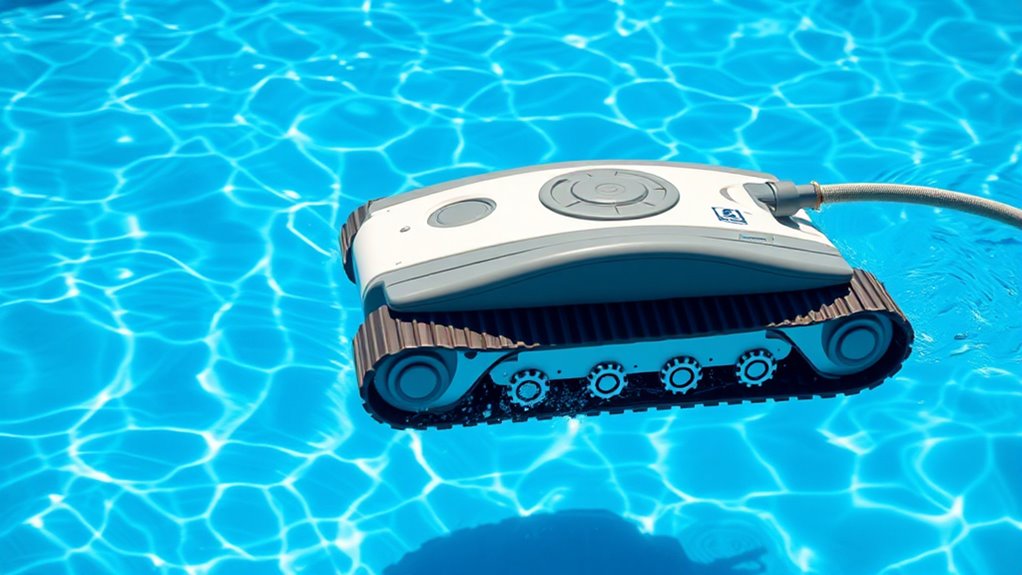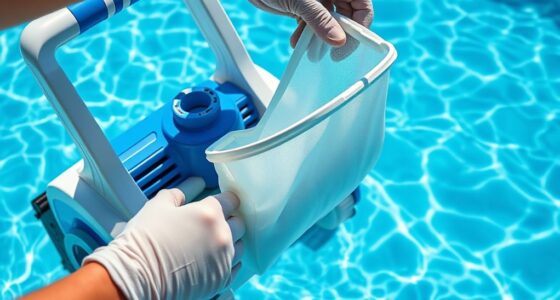To maintain your suction pool cleaner, regularly inspect and clean the skimmer and strainer baskets to prevent debris buildup. Rinse hoses, check for cracks, and make certain all connections are secure. Clean or replace brushes and tracks when worn. Store the cleaner in a shaded, dry area and check the ports for obstructions. Monitoring water chemistry and adjusting suction as needed helps keep your cleaner running smoothly. Learn more tips to keep your cleaner in top shape.
Key Takeaways
- Regularly inspect and clean baskets, filters, hoses, and flotation devices to prevent debris buildup and ensure optimal performance.
- Check intake/discharge ports and the motor for obstructions, wear, and proper suction; clean or replace parts as needed.
- Ensure all components are securely assembled, hoses are leak-free, and brushes or tracks are intact and functioning properly.
- Rinse and clean the cleaner after use, and store it in a dry, shaded area to protect against UV damage.
- Perform routine preventive maintenance by inspecting gear, replacing worn parts promptly, and testing suction efficiency regularly.
Regularly Inspect and Clean the Skimmer and Strainer Baskets
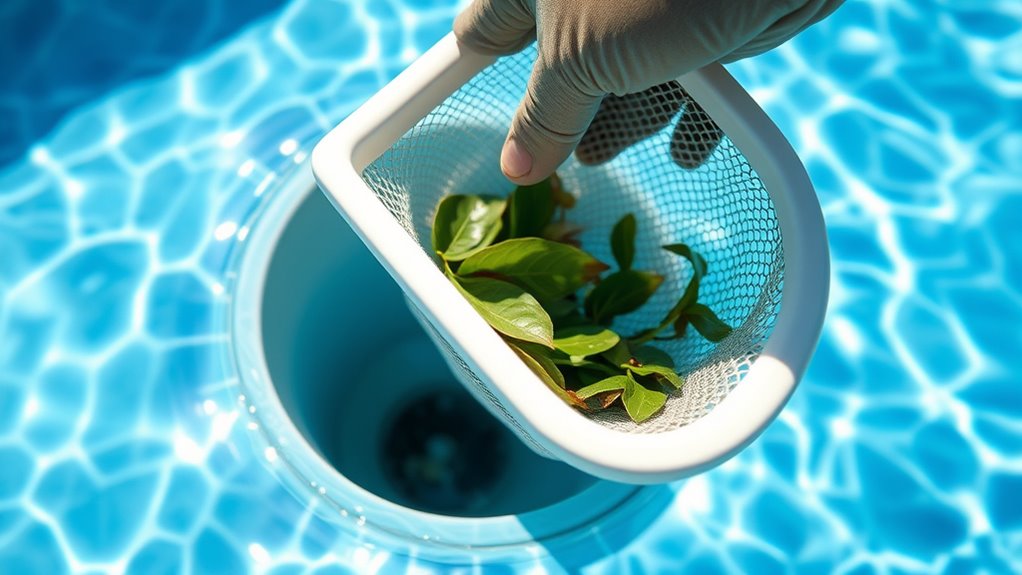
To keep your suction pool cleaner working efficiently, you need to regularly inspect and clean the skimmer and strainer baskets. Dirty baskets can trap debris and reduce water flow, making it harder for your cleaner to do its job. While cleaning, check for signs of pool algae, which can develop quickly if debris isn’t removed. Removing debris helps prevent algae growth and keeps your pool water clear. Also, ensure your pool’s chemical balancing is correct; imbalanced chemicals can promote algae and debris buildup, affecting your cleaner’s performance. Regular maintenance of the baskets maintains proper water circulation and guarantees your cleaner operates smoothly. By staying on top of these small tasks, you prolong the life of your equipment and keep your pool sparkling clean.
Check and Clear the Pool’s Intake and Discharge Ports
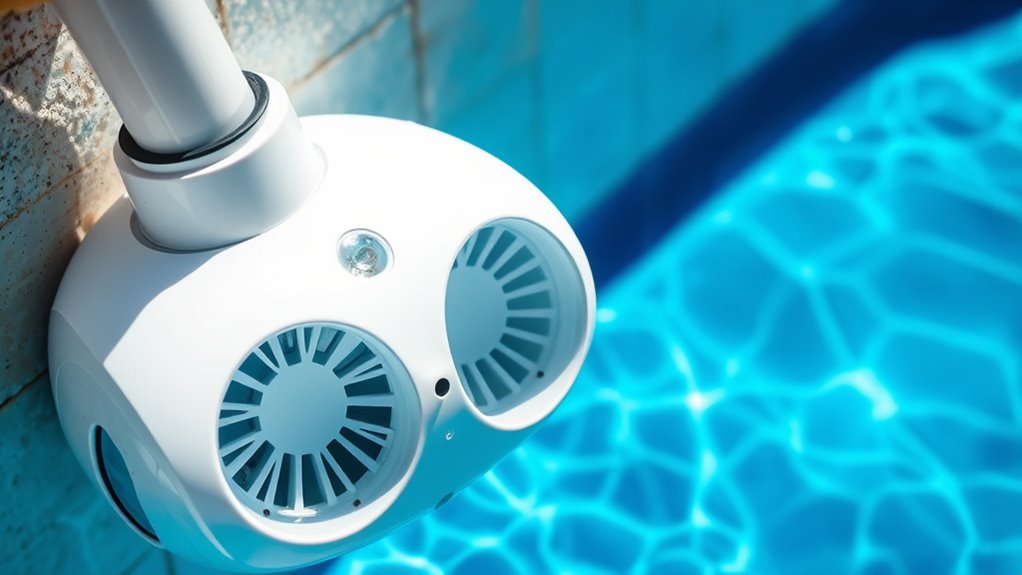
Regularly checking and clearing your pool’s intake and discharge ports guarantees your suction cleaner maintains ideal water flow. Start by inspecting these ports for debris, algae, or obstructions that can reduce suction efficiency. Clear any blockages carefully to prevent strain on the motor, which can lead to overheating or damage. During cleaning, consider if filter replacements are needed, as clogged filters can also hinder water flow and lessen performance. If you notice the cleaner isn’t moving properly or the suction seems weak, motor troubleshooting might be necessary—check for leaks or motor noise. Keeping these ports clean ensures the pump system operates smoothly, reduces wear on components, and prolongs the lifespan of your cleaner. Regular maintenance prevents costly repairs and keeps your pool spotless. Additionally, using Wicking materials for planters can be used to ensure consistent moisture levels around the cleaner’s components, further supporting optimal operation. Moreover, understanding the importance of energy efficiency ratings can help you select equipment that provides optimal performance while conserving energy. Proper vibrational alignment can also contribute to the longevity and efficiency of your pool equipment by minimizing unnecessary vibrations that cause wear. Incorporating data privacy concerns awareness into your maintenance routine can help protect your equipment from cyber threats and unauthorized access.
Rinse and Brush the Cleaner’s Flotation and Hose Components

Start by inspecting the flotation devices to make certain they stay intact and buoyant. Next, rinse the hoses thoroughly and clean the connectors to prevent buildup. Regularly removing debris from these parts keeps your cleaner working smoothly and efficiently. Additionally, check that all safety features are properly functioning to ensure safe operation during pool cleaning. Regular maintenance also includes inspecting the filter system for debris and replacing it if necessary to maintain optimal cleaning performance. Remember to store the cleaner in a dry, shaded area to prolong its lifespan and avoid equipment damage. Incorporating preventive maintenance into your routine can further extend the life of your pool cleaner and improve overall performance. Ensuring proper maintenance can also help prevent air quality issues if your pool environment impacts surrounding air quality.
Inspect Flotation Integrity
Since debris and buildup can weaken flotation components over time, maintaining the cleanliness of the cleaner’s flotation and hose parts regularly is essential. Inspect the floatation system for cracks, chips, or damage that could compromise buoyancy. Confirm the flotation devices are securely attached and properly positioned to maintain ideal buoyancy adjustment. Rinse off any dirt, algae, or debris from the floatation system and hose with a gentle stream of water. Use a soft brush to remove stubborn buildup without damaging the components. Proper inspection and cleaning help preserve the floatation system’s integrity, guaranteeing your pool cleaner remains effective. Regular maintenance can also prevent material degradation that may lead to leaks or failure. Environmental factors such as exposure to sunlight and pool chemicals can accelerate material deterioration, so addressing any signs of wear promptly is crucial to maintain consistent buoyancy and prevent issues during operation. Additionally, inspecting for wear and tear in the flotation components can help identify potential problems before they cause failure. Checking for UV damage can further extend the lifespan of your floatation system. Performing these checks regularly supports the longevity of your pool cleaner and ensures optimal performance.
Clean Hose Connectors
To keep your pool cleaner functioning smoothly, it’s important to rinse and brush the hose connectors and flotation components regularly. Start by disconnecting the hose from the cleaner and pool skimmer. Rinse the hose connection thoroughly with fresh water to remove dirt, algae, and debris. Use a soft brush to gently scrub the hose connectors and flotation parts, paying attention to any buildup that could hinder water flow or cause leaks. Proper connector maintenance guarantees a secure fit and prevents leaks during operation. Check for cracks or damage on the hose connection and replace if necessary. Regular cleaning of these components keeps your suction pool cleaner operating efficiently, prolongs its lifespan, and prevents potential malfunctions caused by debris or buildup in the hose connection. Additionally, being aware of practical support strategies can help address common issues with pool equipment and ensure optimal performance. For example, inspecting the durability of materials used in your cleaner can help identify early signs of wear and tear, reducing the risk of unexpected breakdowns. Incorporating proper maintenance practices can also extend the overall life of your pool cleaning system and improve its efficiency. Maintaining the cleanliness of hose connectors not only prevents clogs but also enhances the performance of the cleaner, ensuring it functions at peak efficiency.
Remove Debris Regularly
How often do you check and clean your pool cleaner’s flotation and hose components? Regular removal of debris is essential for ideal filter maintenance and debris prevention. When you rinse and brush these parts, you help keep the cleaner functioning efficiently and prevent clogs or damage. Proper maintenance techniques ensure longevity and optimal performance of your equipment. Additionally, understanding the importance of pool cleaning can help you maintain a pristine swimming environment and extend the life of your pool accessories.
- Remove leaves, dirt, and sand from flotation devices
- Use a brush to scrub away stubborn debris
- Inspect for cracks or wear in hoses and floats
- Clear any obstructions from hose connectors
- Rinse thoroughly after each use to prevent buildup, and ensure proper gear inspection to identify potential issues early.
- Additionally, understanding the importance of Halloween can inspire you to keep your pool area festive and safe during the season.
Doing this routinely ensures your cleaner stays effective, reduces strain on the motor, and maintains proper suction. Consistent cleaning not only prolongs the life of your cleaner but also keeps your pool sparkling clean.
Examine and Replace Worn or Damaged Brushes and Tracks
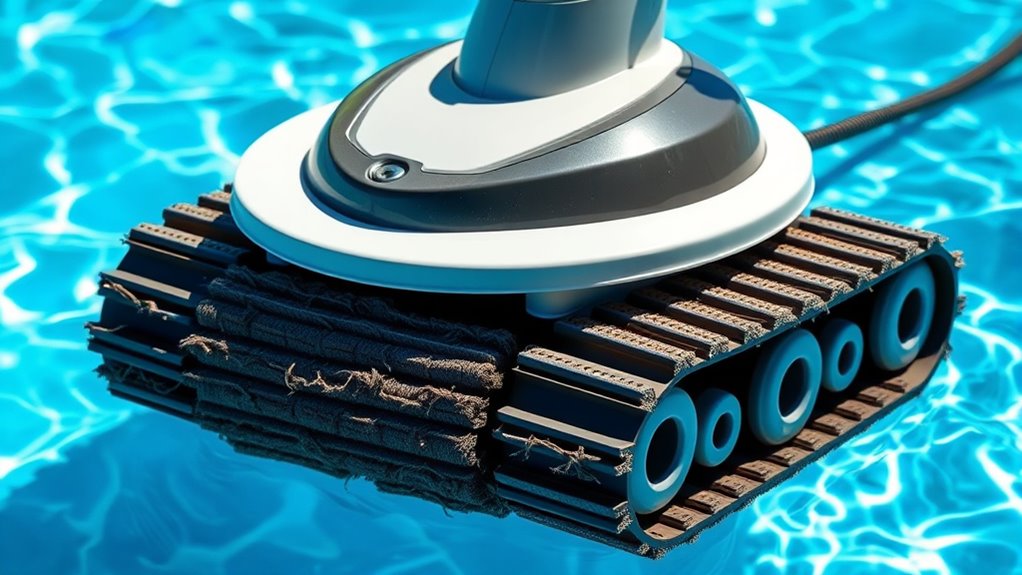
Regularly inspecting the brushes and tracks on your suction pool cleaner is essential for ideal performance. During track inspection, look for cracks, wear, or missing pieces that could hinder movement. Worn or damaged tracks can cause inefficient cleaning or damage to your pool’s surfaces. For brush replacement, check if the bristles are frayed, bent, or missing. Damaged brushes reduce the cleaner’s ability to scrub debris effectively. If you notice any signs of wear, replace the brushes and tracks promptly to maintain excellent cleaning. Always use manufacturer-approved parts to ensure proper fit and function. Regular maintenance of these components keeps your cleaner operating smoothly and prolongs its lifespan. Stay attentive to these details, and your pool cleaner will perform at its best.
Ensure Proper Assembly and Secure Connections
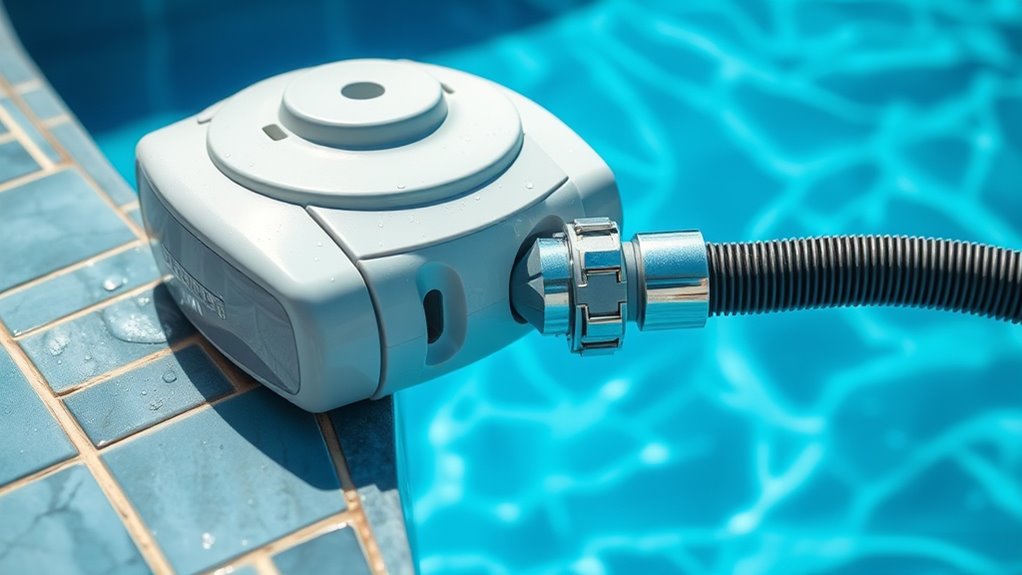
After replacing worn or damaged brushes and tracks, double-check that all parts are assembled correctly. Proper assembly guarantees maximum pool cleaner calibration and maintains strong suction power. Loose or misaligned connections can reduce cleaning efficiency and cause malfunctions. To guarantee secure connections, inspect hoses, fittings, and clamps thoroughly. Also, verify that the intake and discharge ports are correctly aligned. Keep in mind these key points:
- Confirm all hoses are tightly connected and free of leaks
- Ensure the filter and intake valves are properly secured
- Check that the hose swivel and fittings are locked in place
- Adjust the suction power if needed for better performance
- Make sure the cleaner’s brushes and tracks are properly installed
These steps help maintain effective suction and prolong your pool cleaner’s lifespan.
Test the Suction and Adjust As Needed
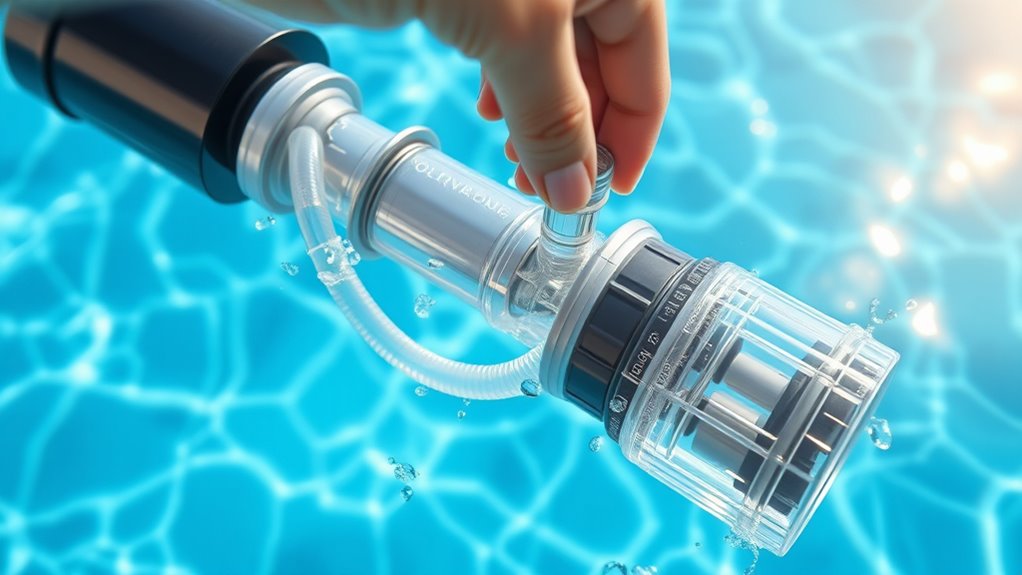
To guarantee your pool cleaner is functioning at its best, you need to test the suction and make any necessary adjustments. Suction testing involves observing how well the cleaner moves across the pool floor and ensuring it stays connected to the hose without losing suction. If the cleaner isn’t moving properly or seems to be losing grip, it’s time for adjustment techniques. Start by checking the skimmer or pump basket for blockages that could weaken suction. Adjust the float or regulator valve to increase or decrease suction pressure. You can also reposition the hose or clean the filter to enhance flow. Regular testing and fine-tuning help maintain ideal suction, ensuring your pool cleaner efficiently cleans without interruption.
Store the Cleaner Properly During Off-Seasons
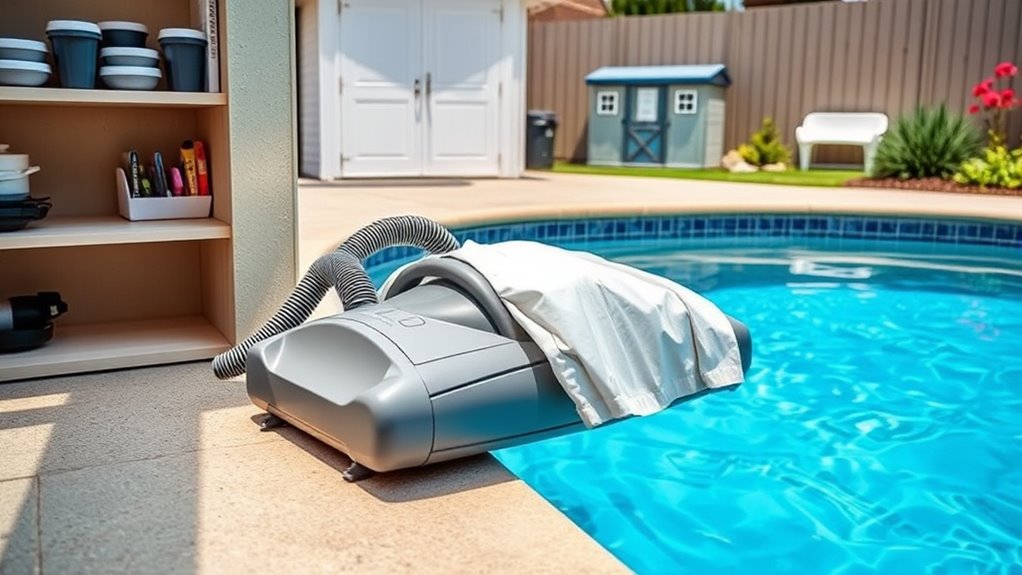
Before storing your pool cleaner, be sure to clean it thoroughly to remove any debris. Pick a dry, shaded spot to keep it protected from moisture and sunlight. Proper storage helps extend its lifespan and guarantees it’s ready for next season.
Clean Before Storage
Properly cleaning your suction pool cleaner before storing it guarantees it stays in good condition and is ready for use when swimming season resumes. Use cleaning supplies like a hose, soft brush, and mild soap to remove dirt, debris, and algae. Rinse thoroughly to prevent mold and mineral build-up. Drain all water from hoses and components to avoid freezing and cracking. Check for any damage or worn parts, replacing if necessary. Store the cleaner in a cool, dry place away from direct sunlight.
Here are some storage tips:
- Remove and clean filters and brushes
- Wipe down with a damp cloth
- Coil hoses loosely to prevent kinks
- Check for any damage before storing
- Keep in a clean, dry area for long-term safety
Choose a Dry Spot
Choosing the right dry spot for storing your suction pool cleaner helps make certain it stays in top condition during the off-season. Find a clean, dry area away from direct sunlight and temperature extremes. If you use solar heating, avoid places where the cleaner could be exposed to intense heat, which may cause damage. A shaded garage or storage shed works well. Before storage, guarantee the cleaner is completely dry to prevent mold or corrosion. Avoid areas where a pool cover might trap moisture or debris around the cleaner. Proper ventilation is essential to keep it in good shape. By selecting an appropriate dry spot, you protect your investment and make sure your suction cleaner is ready to go when pool season returns.
Protect From Sunlight
Sunlight can quickly deteriorate the materials of your suction pool cleaner, so it’s essential to store it in a shaded area during the off-season. UV protection is key to preventing damage from prolonged sun exposure. Using a shade cloth or storing the cleaner indoors helps shield it from harmful rays that can degrade hoses, seals, and plastic components. When storing, ensure the cleaner is clean and dry to prevent mold and corrosion. Keep it off the ground to avoid moisture buildup. Proper storage extends the life of your cleaner and maintains its performance.
- Use a shade cloth or store indoors
- Keep the cleaner in a cool, dry place
- Avoid direct sunlight exposure
- Cover with UV protection if outdoors
- Elevate to prevent moisture contact
Monitor and Maintain the Pool’s Water Level and Chemistry
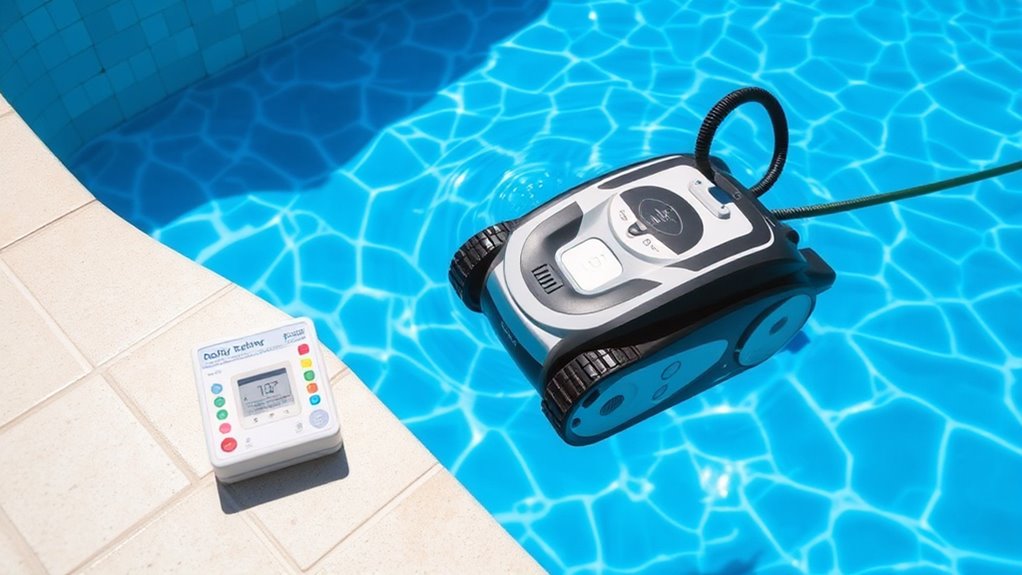
To keep your suction pool cleaner working effectively, you need to regularly monitor and maintain the pool’s water level and chemistry. Proper water level ensures consistent suction and prevents strain on the pump. Keep the water at the skimmer opening or about halfway up the pool’s tile line. Regularly check water chemistry to maintain the chemical balance; improper levels can lead to cloudy water or algae growth. Test your water at least once a week, adjusting chlorine, pH, alkalinity, and stabilizer as needed. Balanced water chemistry also protects your pool equipment from corrosion and scale buildup. Consistent maintenance of water levels and chemistry ensures ideal cleaner performance, extends equipment lifespan, and keeps your pool safe and inviting for swimmers.
Schedule Periodic Professional Servicing

Scheduling regular professional servicing guarantees your pool and its equipment stay in top condition, complementing your routine water level and chemistry checks. A professional ensures your pool’s chemical balance remains ideal, which helps prevent algae buildup and keeps your suction pool cleaner functioning efficiently. During servicing, they inspect and clean filters, check for leaks, and verify pump performance, reducing long-term repair costs. Regular maintenance also extends the lifespan of your equipment and improves water clarity.
- Clean and replace filters as needed
- Adjust chemical levels for proper balance
- Inspect for signs of algae growth
- Check and tighten all fittings and hoses
- Test the pump and motor functionality
Frequently Asked Questions
How Often Should I Replace the Entire Suction Pool Cleaner?
You might wonder about the right replacement schedule for your suction pool cleaner. Generally, you should consider replacing it every 3 to 5 years, depending on usage and condition. Regular maintenance tips, like cleaning filters and inspecting hoses, can extend its lifespan. Keep an eye out for decreased performance or frequent repairs, which signal it’s time for a replacement. Proper care guarantees your cleaner works efficiently and lasts longer.
What Signs Indicate My Cleaner Needs Professional Repair?
You’ll know your suction pool cleaner needs professional repair if you notice poor cleaning performance, unusual noises, or frequent clogging. Routine inspections help you catch issues early, while leak detection can reveal cracks or loose fittings. If cleaning efficiency drops despite cleaning or if the cleaner struggles to move correctly, it’s time to call a professional. Addressing these signs promptly guarantees your pool stays clean and your equipment lasts longer.
Can I Use Household Cleaning Products on the Cleaner?
You shouldn’t use household chemicals on your suction pool cleaner because they can damage its components. These products aren’t designed for cleaner maintenance and may cause corrosion or deterioration. Instead, stick to manufacturer-recommended cleaning methods, like rinsing with fresh water after use. Proper maintenance guarantees your cleaner stays in good shape, works efficiently, and lasts longer without risking damage from household chemicals.
How Do Temperature Changes Affect the Cleaner’S Performance?
Did you know that temperature fluctuation can reduce a suction pool cleaner’s efficiency by up to 30%? When temperatures drop, the cleaner’s parts may become less flexible, slowing its movement and cleaning capacity. Conversely, high temperatures can cause parts to expand, leading to leaks or malfunctions. To keep your cleaner running smoothly, monitor water temperature and avoid extreme fluctuations, ensuring consistent performance and longer lifespan.
Is It Necessary to Upgrade Parts Periodically for Efficiency?
You might wonder if part replacement or upgrade necessity influences your cleaner’s efficiency. Regularly inspecting your suction pool cleaner helps spot worn or damaged parts that need substitution. Upgrading certain parts, like brushes or filters, can boost performance and extend the cleaner’s lifespan. Staying proactive ensures your cleaner works efficiently, saving you time and money in the long run. Remember, timely part replacement keeps your pool cleaner running smoothly.
Conclusion
By regularly inspecting, cleaning, and maintaining your suction pool cleaner, you guarantee it works efficiently, lasts longer, and keeps your pool sparkling. Check the baskets, clear the ports, rinse and brush components, and replace worn parts. Test and adjust the suction, store it properly in the off-season, and keep your water balanced. Stay proactive with professional servicing—because consistent care leads to a cleaner, healthier pool all season long.
